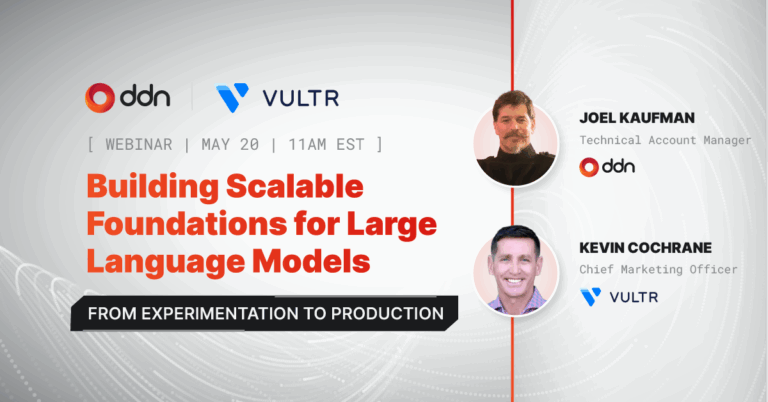Key Takeaways
- A staggering 1000x growth in model size for LLMs in the last few years has revealed challenges with memory limitations and resource utilization during training and inference.
- Software stacks aim to optimize memory usage and offload parts of the model from GPU memory to other storage forms like local NVME, but this approach may not be the most optimal architecture for massive LLMs.
- A parallel filesystem appliance offers superior performance and simple scalability, where key advantages lie in the ability to scale out to hundreds of gigabytes per second for read and write operations, as well as efficient data transfer to individual GPUs or GPU systems.
- When making architectural choices for deploying LLMs and other AI tools, it is crucial to consider the future growth of these models over the next five years. With all the attention paid to GPU computing, it is also important to consider the backend data infrastructure that supply them.
Large language models (LLMs) are being applied to a wide range of tasks, including enhanced search, content generation, content summarization, retrieval-augmented generation (RAG), code generation, language translation and conversational chat. These powerful models have taken the field of natural language processing (NLP) by storm because they have demonstrated significant capabilities across various domains and industries. While traditional NLP tools have their place, it is clear that LLMs powered with general-purpose capabilities like Microsoft Bing and ChatGPT reflect their immense potential.
These LLMs are scale-up models, boasting billions to trillions of parameters, and consistently outperform their smaller counterparts. In just a few years, we have witnessed a staggering 1000x growth in model size. However, this growth comes with its own set of challenges, particularly when it comes to memory limitations and resource utilization during training and inference.
To address these challenges and prepare for the next 1000x increase in model size, several software stacks have been developed. These stacks optimize memory usage and offload parts of the model from GPU memory to other storage forms like local NVME. While this approach has its merits, it may not be the most optimal architecture for massive LLMs, which are projected to become common in the next few years.
In this white paper, Large Language Models: The Rise of Data, we introduce a solution to efficiently optimize the training performance for these large LLMs: the AI400X2 Storage Appliance from DDN. Our parallel filesystem appliance offers superior performance and simple scalability, outperforming local storage solutions by a significant margin. The key advantages of the AI400X2 lie in its ability to scale out to hundreds of gigabytes per second for read and write operations, as well as its efficient data transfer to individual GPUs and GPU systems. This makes it the ideal choice for running LLMs efficiently.
To demonstrate the superiority of the AI400X2, we conducted extensive tests using the ZeRO-Infinity offloading feature from the DeepSpeed library on a single eight-GPU system. The results speak for themselves: the DDN AI400X2 achieved nearly 2x the performance of local RAID storage while enabling the use of larger models (up to 24 trillion parameters on a single node during our testing). On the other hand, GPU, CPU, and local NVME solutions face limitations that either make them unusable or extremely expensive.
But it is not just about performance. The AI400X2 also offers a simple approach to increasing capacity, making it the ideal solution capable of handling the tested model sizes for inference, for even the largest LLM projections. For training and fine-tuning, where memory requirements are even higher, the AI400X2’s advantages become even more pronounced. Extrapolating from our results, we estimated that over 750 GPU systems would be needed to fit a model the size of BLOOM-mod-2 in GPU memory, compared to just four AI400X2 appliances and a single GPU computing system with offloading enabled.
The implications of these findings are profound. While running such massive models on a single node during pre-training may seem impractical at present, it advances exciting possibilities for fine-tuning, inference, and the growing interest in sparse models that decouple computation from model size.
In conclusion, large language models hold tremendous promise for enterprises seeking to create value and gain a competitive edge. When making architectural choices for deploying LLMs and other AI tools, it is crucial to consider the future growth of these models over the next five years. With all the attention paid to GPU computing, it is also important to consider the backend data infrastructure that supplies these GPUs. DDN’s AI400X2 storage appliance offers a long-term solution that can accommodate this growth while enhancing efficiency and simplicity.
The future of large language models is here, and DDN is at the forefront of this revolution. Embrace the power of the AI400X2 and unlock new possibilities for your enterprise in the world of generative AI.



